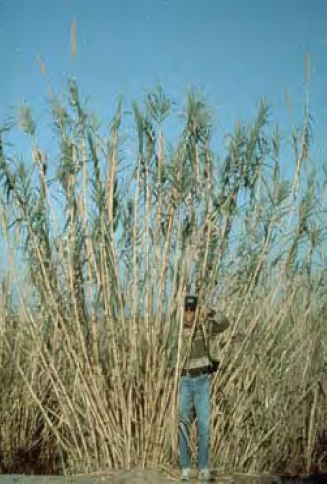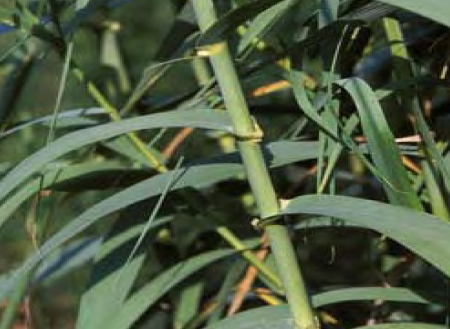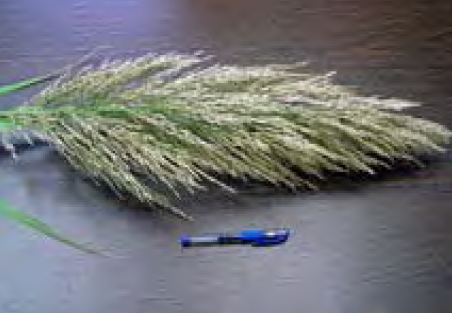Introduction
Giant reed, also known as giant cane, Arundo, and Spanish reed, originated on the Indian subcontinent. It has invaded Hawaii and the southern United States, including southern Nevada. Arundo grows rapidly in warm climates and wet soils, quickly crowding out native plants and consuming surface and ground water. Its dense stands in riparian areas provide little food or habitat for native wildlife. Its root mass holds stream and river banks, altering water flow and changing flood plains. As it dies back each season, the mass of dried grass creates a fire hazard and debris that clogs water diversion structures. It grows and spreads from seed, shoots, crowns, and roots. Giant reed is a noxious weed in Nevada.

Distinguishing features
- A perennial, clump-forming grass, it grows from 6 to 20 feet tall.
- Stems are hollow, bamboo-like, and can grow 11/2 inches in diameter.
- Green leaf blades are long and broad. Some varieties have variegated leaves.
- Flower clusters are long, greenish to whitish to purplish, and plume-like.
- Giant reed spreads quickly from rhizomes and can resprout from a piece of root or stem to form a new plant.


This weed crowds out desirable forage and alters native habitats. It exists in the southern United States and is spreading rapidly to new areas, especially waterways
Take action
- Report its location to the landowner, gardener, manager, park ranger, or weed district supervisor.
- Remove all plant pieces from clothing, shoes, pets, camping gear, vehicle, and tire treads before moving out of an infested area.
- Monitor lake shores and ditch, stream, and river banks. If a few plants are found, remove them, roots and all. Dispose of the plant and roots, all of which can grow a new plant, in a sealed garbage bag in the trash. Herbicides are also available to kill this plant.
Your reward
A cleaner, healthier environment and the satisfaction that you have helped make a difference!
For more information about controlling this and other invasive weeds, contact
- University of Nevada Cooperative Extension 775-784-1334;
- Nevada Department of Agriculture 775-688-1182; or
- Your local Weed District manager or Conservation District
The “Wanted: Dead—Not Alive!” posters are part of an overall campaign to manage invasive and noxious weeds in Nevada. These posters are available through the University of Nevada Cooperative Extension, Integrated Pest Management Office, Department of Resource Economics / MS 204, University of Nevada, Reno, Reno, NV 89557-0105. They are also available on the UNCE website. Information may be copied in its entirety for educational use. Local weed districts and other organizations may add their office address and phone number at the bottom of each poster. Information on quantity printing may be obtained by contacting the IPM office or calling (775) 784-1931.
The following posters of Nevada’s noxious weeds are available
- African Rue
- Austrian Fieldcress
- Austrian Peaweed
- Black Henbane
- Bull Thistle*
- Camelthorn
- Canada Thistle
- Carolina Horsenettle
- Common Crupina
- Dalmatian Toadflax
- Diffuse Knapweed
- Dyer’s Woad
- Eurasian Watermilfoil
- Giant Reed
- Giant Salvinia
- Goatsrue
- Green Fountaingrass
- Hoary Cress/Whitetop
- Houndstongue
- Hydrilla
- Iberian Starthistle
- Johnsongrass
- Leafy Spurge
- Malta Starthistle
- Mayweed Chamomile
- Mediterranean Sage
- Medusahead
- Musk Thistle
- Oxeye Daisy*
- Perennial Pepperweed/Tall Whitetop
- Perennial Sowthistle
- Poison Hemlock
- Puncturevine
- Purple Loosestrife
- Purple Starthistle
- Rush Skeletonweed
- Russian Knapweed
- Sahara Mustard
- Saltcedar/Tamarisk
- Scotch Thistle
- Spotted Knapweed
- Squarrose Knapweed
- St. Johnswort/Klamath Weed
- Sulfur Cinquefoil
- Syrian Beancaper
- Western Waterhemlock
- White Horsenettle
- Wild Licorice*
- Yellow Starthistle
- Yellow Toadflax
* Not a noxious weed in Nevada
Johnson, W. and Strom, S.
2021,
Giant Reed,
Extension | University of Nevada, Reno, FS-06-21


